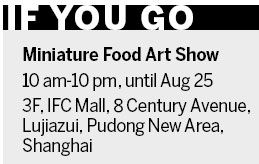 |
|
Photo provided to China Daily
|
Visitors will crave a bite of the minuscule desserts. However, these inviting looking foods are not edible as they are made of polymer clay.
Using scalpels, art knives and toothpicks to mould, Kilgast takes up to three hours to create a piece, while a whole set, often takes her months to construct.

Detailing the artwork using simple acrylic paints, Kilgast uses a magnifying glass to help her with the intricate design. To make them vivid, she observes sharply the variation in color and shades of the sustenance.
Kilgast discovered her passion for miniatures in 2007, when she was looking for a new hobby to keep her occupied over the summer holidays at university. She realized creating miniatures took her back to a time when she was a little girl, making tiny food out of clay for her Barbie dolls.
The passion grew, and now she makes a living from making her tiny model food, and has written a book on how to make them.
Kilgast has now started to turn her food art into jewelry by adding clasps and hooks to them.
"Miniatures are usually appreciated because they make you think you can put the world in your pocket," she says.
We recommend:
